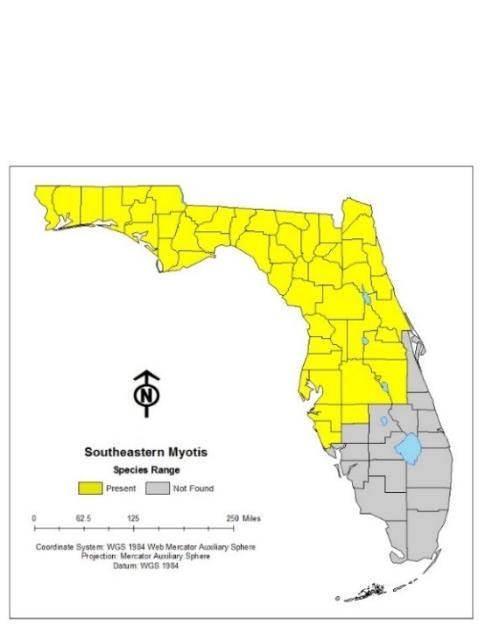The southeastern myotis is a forest- and cave-dwelling bat. Southeastern myotis are relatively small bats, weighing 5–8 grams (approximately as much as 1 or 2 US quarters) and have a wingspan of 9–10.5 inches (23.8–27.0 cm). Southeastern myotis are dull in color, with short, wooly fur that is gray to brown on their backs and light yellow or cream on their undersides. Unlike many other species in Florida, southeastern myotis have long hairs between their toes that extend past their claws.

Credit: Jeff Gore, FWC
Southeastern myotis bats are found throughout the southeastern United States and as far north as Indiana. Their Florida range extends across the entire panhandle and down into the central portion of the state as far south as Sarasota, Hardee, and Osceola counties (Figure 2).

During the spring and summer, southeastern myotis often roost (sleep during the day) in caves. An advantage of caves is the stable temperatures and humid microclimate they provide. These bats give birth to live young in the spring and summer months, which is often referred to as the maternity season. Large numbers of female southeastern myotis gather in these maternity colonies in the early spring (March) and give birth to twins in May. Of the 16 species of Myotis bats in the United States, the southeastern myotis is the only species that gives birth to more than one pup. The pups are able to fly and find food on their own 5 to 6 weeks after birth.
The southeastern myotis uses other structures as roosts in addition to caves, like tree cavities, concrete bridges, culverts, buildings, and bat houses. The number of individuals per roost can be small, but sometimes reaches several thousand individuals. These bats can be found roosting in man-made structures with other bat species, notably Brazilian free-tailed bats and evening bats, or in caves with tricolored bats.

Credit: Merlin Tuttle, Merlin Tuttle's Bat Conservation
The southeastern myotis is one of only three species of bats in Florida that hibernate in caves during the winter. Across North America, many bats that hibernate in caves are susceptible to a deadly disease called white nose syndrome (WNS). This disease has killed many millions of cave-dwelling bats across eastern North America since it first appeared in 2006. WNS is caused by a fungus that has not been found in Florida caves to date. Biologists are carefully monitoring Florida's caves so they will know if WNS appears.
Southeastern myotis, like most of Florida's bats, are insectivorous and forage at night. They feed on small insects such as mosquitoes, moths, beetles, and aquatic insects. They often forage low over ponds, streams, and swamps.
Distinguishing the Southeastern Myotis from Similar Florida Bat Species
The southeastern myotis is a small bat with dark to grayish brown fur on its back and lighter fur on its underside. It has short, dark brown ears and long toe hairs on its hind feet. The species in Florida that the southeastern myotis is most similar to in appearance are the evening bat and tricolored bat.
Read below to determine how to differentiate southeastern myotis from other similar species found in Florida.
Southeastern Myotis
- Fur ranges from gray to brown to reddish on the back and buff to tan on the stomach.
- Wing membranes are dark brown, as are wing bones, and the muzzle is mostly furred.
- The base of each wing is attached to the inner toe of each foot.
- Long hairs between the toes extend past the claws.
- The body is small, approximately 2 inches (48–53 mm) from nose to rump.
- Bats roost in colonies ranging from 100 to 10,000 in caves and tree cavities, beneath concrete bridges and culverts, and in houses and bat houses.
Evening Bat
- Fur is brown to dark brown on the back and buff to tan on the stomach.
- The bat resembles the big brown bat but is much smaller.
- Wing membranes are dark brown, as are wing bones; ears and muzzle are unfurred.
- The body is small, approximately 2.3 inches (49–67 mm) from nose to rump.
- Bats roost in fairly small groups numbering up to 100 individuals in tree cavities, beneath tree bark, in concrete bridges, beneath caps on top of utility poles, in folded patio umbrellas, in houses, and in bat houses.
- They may share roosts with Brazilian free-tailed bats and southeastern myotis bats.
- Bats forage in many habitat types throughout the state.
Tricolored Bat
- Fur ranges dramatically in color among individuals from pale silver-yellow to dark orange.
- Wing membranes are blackish and contrast sharply with wing bones, which are pink.
- The body is very small, approximately 2 inches (36–52 mm) from head to rump.
- Small forearm is approximately 1 1/3 inches (31–36 mm).
- Bats roost singly or in small groups of 2–3 in caves, tree cavities and tree foliage, Spanish moss, and buildings.
- They may share roosts with Brazilian free-tailed bats, evening bats, and southeastern myotis.
- Bats forage along tree lines and over ponds and streams throughout the state.
Additional Information
Florida Fish and Wildlife Conservation Commission. Living with bats.
Marks, C. S., and G. E. Marks. 2006. Bats of Florida. University Press of Florida. Gainesville, Fl. 176 pp.
Ober, H. K., M. B. Main, and G. M. Allen. 2004. Bats of Florida. WEC186. Gainesville: University of Florida Institute of Food and Agricultural Sciences. https://edis.ifas.ufl.edu/publication/uw203
Ober, H. K., and F. J. Mazzotti. 2008. Conservation of Bats in Florida. WEC247. Gainesville: University of Florida Institute of Food and Agricultural Sciences. https://edis.ifas.ufl.edu/publication/uw291
Ober, H. K. 2008. Effective Bat Houses for Florida. WEC246. Gainesville: University of Florida Institute of Food and Agricultural Sciences. https://edis.ifas.ufl.edu/uw290
Ober, H. K. 2008. Insect Pest Management Services Provided by Bats. WEC245. Gainesville: University of Florida Institute of Food and Agricultural Sciences. https://edis.ifas.ufl.edu/publication/uw289
Wisely, S. M., and H. K. Ober. 2015. Facts about Wildlife Diseases: Rabies. WEC239. Gainesville: University of Florida Institute of Food and Agricultural Sciences. https://edis.ifas.ufl.edu/uw282